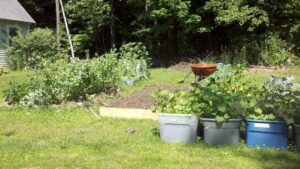Miracle Gro

BLUF: Miracle Gro is basically minerals salts and coloring, which can (but doesn’t always) help short term, but long term will destroy the beneficial things in your soil. It’s expensive and messy and can harm your vegetables. Free and low cost alternatives include animal manure, natural mulch, etc… all of which add to rather than depleting from the soil.
I’m not sure if any of you are aware of the demon Monsanto. Coming from the Left, as I do, I have a real hate for Monsanto. However, I also learned hate for them through local farmers who are very conservative Trump supporters. Monsanto is not a good company, for a LOT of reasons. I don’t want to write about them, so I am offering you an article to go read at your own pace (yes, the site is anti-Trump, but their information on this topic is not bad).
Now to Miracle Gro. There’s an incestuous relationship between Monsanto and Miracle Gro which makes me uneasy. Monsanto doesn’t own it Miracle Gro, nor vice versa, but there’s a lot going on between them. That alone is enough to warn me off, however, there’s more. MG was successfully sued for lying about pesticides in their bird food that they manufactured and sold, which led to the death of enough song birds to cause a lot of people to get upset. I realize one legal case by a rabid leftist isn’t enough to cause a conservative to flinch, as it could always just be one they settled out of court to get the suing party to shut up. So I present you with a tracking website keeping dibs on all the court cases MG has lost.
There are places for chemicals. I use chemicals in the garden from time to time. I use chemicals against wasps, because they’re stingy assholes and I’m allergic. There are times when it’s just right to use chemicals. But if you’re paying extra to get something free of chemicals, if you’re actively looking to avoid chemicals, and a company sells you something it says is chemical free and it is not… that’s just not right. And that’s what Miracle Gro seems to be doing.
It’s not even that it’s necessarily “bad chemicals” in their products. I believe that ever MG product has salt in it. While tiny amounts of salt can help add things to your soil that benefit your plants, at least in the short term, it destroys your soil in the long term. Ever heard of Romans “salting the earth” before leaving an area? That’s so the enemy couldn’t plant crops for 20 years or more. That’s how bad salt is for your garden.
If you want to give good fertilizer to your garden and improve your soil, pick up some bunny poop and make bunny poop tea, and use that to water your plants. Pick up some local well aged manure and shovel that in around your plants. Most of the time, if you’re dealing with local folk, it will cost you nothing or very little, because you’re saving those people from having to remove the manure themselves.








 Larry Correia of Monster Hunter warned about the Dem’s white signs from Trump’s speech yesterday. He said they would live to regret using white signs, because they’re so easy to manipulate into memes. He was right. This picture says it all (and says the truth, where the originals probably didn’t). This is a good meme. First, it’s true. Anytime a meme can highlight truths (harsh or otherwise) it’s good. There’s nothing nasty about this, BECAUSE it speaks the truth.
Larry Correia of Monster Hunter warned about the Dem’s white signs from Trump’s speech yesterday. He said they would live to regret using white signs, because they’re so easy to manipulate into memes. He was right. This picture says it all (and says the truth, where the originals probably didn’t). This is a good meme. First, it’s true. Anytime a meme can highlight truths (harsh or otherwise) it’s good. There’s nothing nasty about this, BECAUSE it speaks the truth. But then we have this. I have real problems with this one. First, it’s insulting on a whole other level. It implies several things to me. First, it says that American voters are so dumb that they’d attempt to have Trump in for a third term. Second, it says Dems are pushing hard for a Trump third term (and while I might agree many of them are stupid enough to do so accidentally, this one’s over the top). But most importantly, it gives the impression that the Republicans don’t care about the Constitution.
But then we have this. I have real problems with this one. First, it’s insulting on a whole other level. It implies several things to me. First, it says that American voters are so dumb that they’d attempt to have Trump in for a third term. Second, it says Dems are pushing hard for a Trump third term (and while I might agree many of them are stupid enough to do so accidentally, this one’s over the top). But most importantly, it gives the impression that the Republicans don’t care about the Constitution.


 This image came across my Facebook page this morning. It had the following rant attached:
This image came across my Facebook page this morning. It had the following rant attached: